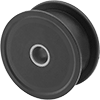Filter by
Roller Material
Bearing Material
Weight Capacity
Width
Axle Grip Type
Maximum Temperature
Export Control Classification Number (ECCN)
DFARS Specialty Metals
Ball Bearing Material
Material Handling
Power Transmission
Building and Machinery Hardware


































